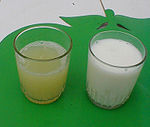Translations:Effects of climate change on livestock/29/en
Heatwaves can also reduce milk yield, with particularly acute impacts if the heatwave lasts for four or more days, as at that point the cow's thermoregulation capacity is usually exhausted, and its core body temperature starts to increase. At worst, heatwaves can lead to mass mortality: in July 1995, over 4,000 cattle in the mid-central United States heatwave, and in 1999, over 5,000 cattle died during a heatwave in northeastern Nebraska. Studies suggest that Brahman cattle and its cross-breeds are more resistant to heat stress than the regular bos taurus breeds, but it is considered unlikely that even more heat-resistant cattle can be bred at a sufficient rate to keep up with the expected warming. Further, both male and female cattle can have their reproduction impaired by heat stress. In males, severe heat can affect both spermatogenesis and the stored spermatozoa. It may take up to eight weeks for sperm to become viable again. In females, heat stress negatively affects conception rates as it impairs corpus luteum and thus ovarian function and oocyte quality. Even after conception, a pregnancy is less likely to be carried to term due to reduced endometrial function and uterine blood flow, leading to increased embryonic mortality and early fetal loss. Calves born to heat-stressed cows typically have a below-average weight, and their weight and height remains below average even by the time they reach their first year, due to permanent changes in their metabolism. Heat-stressed cattle have also displayed reduced albumin secretion and liver enzyme activity. This is attributed to accelerated breakdown of adipose tissue by the liver, causing lipidosis.

Cattle are suspectible to some specific heat stress risks, such as ruminal acidosis. Cattle eat less when they experience acute heat stress during hottest parts of the day, only to compensate when it is cooler, and this disbalance soon causes acidosis, which can lead to laminitis. Additionally, one of the ways cattle can attempt to deal with higher temperatures is by panting more often, which rapidly decreases carbon dioxide concentrations and increases pH. To avoid respiratory alkalosis, cattle are forced to shed bicarbonate through urination, and this comes at the expense of rumen buffering. These two pathologies can both develop into lameness, defined as "any foot abnormality that causes an animal to change the way that it walks". This effect can occur "weeks to months" after severe heat stress exposure, alongside sore ulcers and white line disease. Another specific risk is mastitis, normally caused by either an injury to cow's udder, or "immune response to bacterial invasion of the teat canal." Bovine neutrophil function is impaired at higher temperatures, leaving mammary glands more vulnerable to infection, and mastitis is already known to be more prevalent during the summer months, so there is an expectation this would worsen with continued climate change.